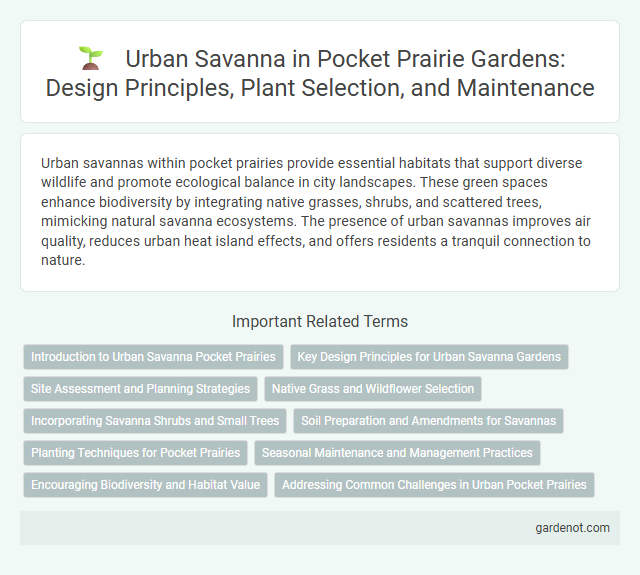Urban savannas within pocket prairies provide essential habitats that support diverse wildlife and promote ecological balance in city landscapes. These green spaces enhance biodiversity by integrating native grasses, shrubs, and scattered trees, mimicking natural savanna ecosystems. The presence of urban savannas improves air quality, reduces urban heat island effects, and offers residents a tranquil connection to nature.
Introduction to Urban Savanna Pocket Prairies
Urban savanna pocket prairies are small-scale, biodiverse ecosystems designed to mimic natural savanna landscapes within city environments. These green spaces play a crucial role in supporting native flora and fauna, enhancing urban biodiversity, and improving ecosystem services such as air quality and stormwater management. Integrating pocket prairies into urban planning fosters resilient habitats that contribute to environmental sustainability and community well-being.
Key Design Principles for Urban Savanna Gardens
Urban savanna gardens emphasize native prairie grasses, scattered trees, and shrub clusters to mimic natural savanna ecosystems. Key design principles include selecting drought-tolerant, low-maintenance plants that support local wildlife and promote biodiversity in urban settings. Incorporating permeable soils and strategic plant layering enhances water infiltration and creates habitat connectivity within pocket prairies.
Site Assessment and Planning Strategies
Site assessment for urban savanna restoration involves evaluating soil composition, existing vegetation, local climate, and hydrology to ensure the viability of pocket prairies. Planning strategies prioritize native grass and wildflower species that support biodiversity, enhance urban wildlife habitats, and improve stormwater management. Integrating these elements promotes ecological resilience and sustainable green spaces within densely developed urban environments.
Native Grass and Wildflower Selection
Urban savanna restoration in pocket prairies thrives on selecting native grasses and wildflowers that support local biodiversity. Species such as Little Bluestem (Schizachyrium scoparium) and Purple Coneflower (Echinacea purpurea) enhance soil health, attract pollinators, and provide habitat for urban wildlife. Careful selection of drought-tolerant, sun-loving native plants ensures ecological resilience and vibrant seasonal color throughout the year.
Incorporating Savanna Shrubs and Small Trees
In urban savanna restoration, incorporating savanna shrubs and small trees enhances biodiversity and strengthens ecosystem resilience by providing essential habitat and food sources for native wildlife. Species like American hazelnut, serviceberry, and chokecherry contribute to layered vegetation structure, improve soil health, and support pollinators. Strategic planting of these woody plants in pocket prairies creates microhabitats that mimic natural savanna conditions, fostering ecological balance in urban green spaces.
Soil Preparation and Amendments for Savannas
Effective soil preparation for urban savannas involves loosening compacted soil to enhance root penetration and water infiltration. Incorporating organic amendments such as compost, biochar, and native mulch improves soil structure, nutrient retention, and microbial activity essential for savanna plant health. Testing soil pH and nutrient levels guides tailored amendments, ensuring optimal conditions for native grass and tree species typical of pocket prairies.
Planting Techniques for Pocket Prairies
Urban savanna pocket prairies thrive through strategic planting techniques that emphasize native grasses and wildflowers, fostering biodiversity and resilient ecosystems. Selecting plant species adapted to local climate conditions enhances survival rates and reduces maintenance, promoting sustainable growth in urban environments. Layering plants by height and root depth maximizes space utilization and supports diverse wildlife habitats within limited city spaces.
Seasonal Maintenance and Management Practices
Urban savannas within pocket prairies require seasonal maintenance to support native plant health and biodiversity. Regular practices include controlled mowing in late fall to remove dead biomass and minimize invasive species growth and selective brush clearing during early spring to enhance sunlight penetration and promote native grasses. Monitoring soil moisture and applying drought-resistant strategies during dry summer months optimize plant resilience and ecosystem function.
Encouraging Biodiversity and Habitat Value
Urban savannas within pocket prairies support diverse native plant species, creating critical habitats for pollinators, birds, and small mammals. These ecosystems enhance urban biodiversity by providing food sources and shelter, promoting ecological resilience. Maintaining native grasses and wildflowers fosters natural pest control and soil health, increasing habitat value in city landscapes.
Addressing Common Challenges in Urban Pocket Prairies
Urban savannas in pocket prairies face challenges such as soil compaction, invasive species, and limited biodiversity that hinder ecosystem resilience and native plant growth. Implementing targeted soil restoration techniques, integrated pest management, and selecting native, drought-tolerant plant species significantly improves habitat quality and urban wildlife support. Strategic maintenance practices enhance ecological functions, promoting sustainable green spaces in densely built environments.
Urban savanna Infographic

 gardenot.com
gardenot.com